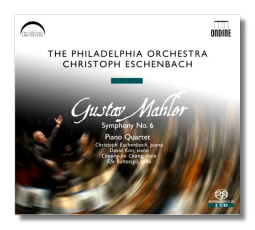
The Internet's Premier Classical Music Source
Related Links
- Mahler Reviews
- Latest Reviews
- More Reviews
-
By Composer
-
Collections
DVD & Blu-ray
Books
Concert Reviews
Articles/Interviews
Software
Audio
Search Amazon
Recommended Links
Site News
 SACD Review
SACD Review
Gustav Mahler

- Symphony #6
- Piano Quartet Movement in A minor *
* Christoph Eschenbach, piano
* David Kim, violin
* Choon-Jin Chang, viola
* Efe Baltacigil, cello
Philadelphia Orchestra/Christoph Eschenbach
Ondine SACD ODE1084 2CDs 54:21, 44:17
My God, this is a scary Mahler Sixth. Would a true admirer of this composer have it any other way?
This is the third of Eschenbach's recordings with the Philadelphia Orchestra for Finland's Ondine label. Unfortunately, it also is likely to be the last, as I understand that Eschenbach and Philadelphia are parting ways after just a few seasons. Eschenbach came onto the international scene in the 1960s as a pianist, but he has been conducting since 1972. His previous Philly recording (Tchaikovsky's Fifth, coupled with the first half of The Seasons) presented him in both roles, and this one does as well.
The Brahmsian Piano Quartet movement offered here is the work of a teenaged Mahler, several years before he composed Das klagende Lied. It is an incomplete work, of course, but one that promises much, particularly in the way that the young composer follows sonata form and yet creates something that is typical of him in its sweep and coherence, over a 13-minute span. It is played here with dark and mournful intensity by Maestro Eschenbach and three members of the Philadelphia Orchestra.
Mahler's Sixth is one of his most puzzling symphonies, not least because conductors still cannot agree what his intentions were, not just in terms of meaning, but also in terms of movement order and orchestration. Eschenbach's solution is something of a compromise: he uses the movement order of the first version (with the Scherzo before the Andante moderato) but the orchestration of the second version. There are only two hammer blows in the Finale. (Ondine's booklet note writer tells us that there were five hammer blows in Mahler's first conception of this movement!)
This is a fairly subjective reading of the symphony, and most of the subjectivity comes from Eschenbach's flexibility over tempo. (Some might prefer the word "waywardness.") Following the score, one will note that Eschenbach is not reticent about ignoring or contradicting Mahler's markings, and yet the conductor's innovations never feel self-indulgent, which is not something one could have said about Leonard Bernstein (for example) in his powerful readings of the Mahler canon. Overall, I found Eschenbach's tempos to be very well judged; the music holds together without being rushed, although there are times when one wishes that the conductor would linger more, so beautiful are the sounds issuing from the Philadelphia Orchestra. Although there are many surprising and convincing details in this reading, it is the big picture, the rush to annihilation in the last movement, that ultimately impresses. Initially, one might feel that the first and (especially) the second movements are too plain-spoken, but Eschenbach's restraint in the first three movements pays off in a Finale that is emotionally shattering, as Mahler surely must have intended.
Ondine's engineering is a marvel – it almost makes the speakers disappear, erasing the barrier between the listener and the musicians. One can hear the character in the playing, which is not something one noted during the Sawallisch years, at least on CD. The instruments are virtually tangible in the softer passages, and Mahler's loud climaxes are given their terrifying due. Indeed, the first hammer blow in the Finale tripped the protection circuit in my amplifier, shutting it down for a half-second. (I took this as a suggestion to turn the music down!) Part of what makes this music great is the visceral impact it can have on listeners, and therefore, the engineering on this recording is an important factor, not just a shallow bit of trivia for audiophiles. I have not joined the ranks of SACD-player owners. I would like to think that this recording makes an even greater impact on such equipment.
These are live recordings; the symphony is from November 2005, and the Piano Quartet from March 2006. The audiences applaud at the end, but otherwise they are well-behaved, and they will not distract anyone from the compelling power of the music-making on these CDs. This is a must-hear, and not just for Mahlerites.
Copyright © 2007, Raymond Tuttle




















